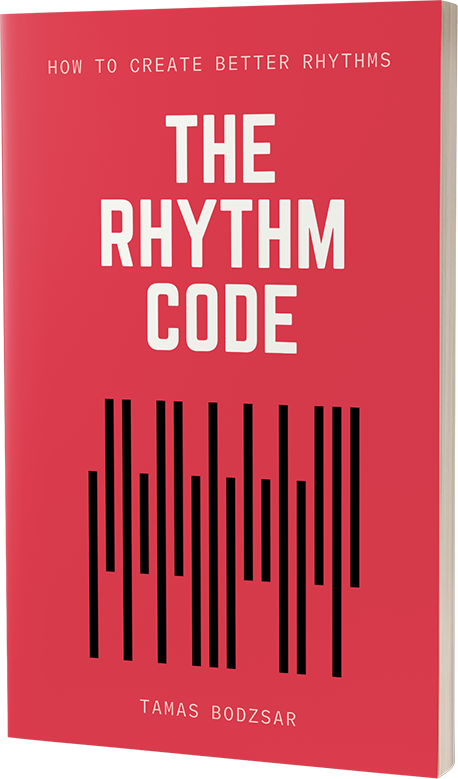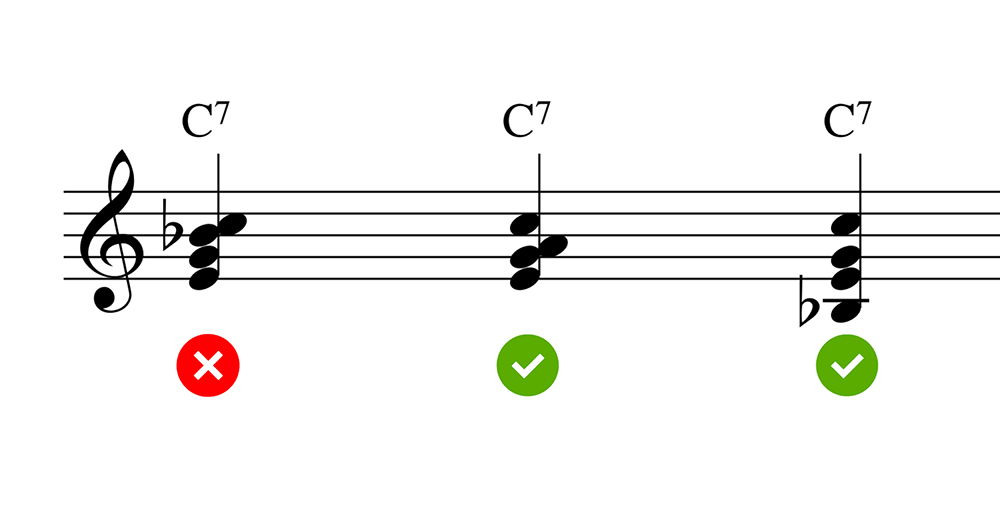
In the previous post, I explained how you can find the best chords for your melody. In this post, I will explain how you can arrange a vocal melody in a way, so it becomes a 3-part, 4-part, or even a 5-part vocal melody.
I assume that you already have the chord progression for your melody, in fact, it is crucial to have the chords, so if you only have the melody, then go back to our previous post to find the right chords for the melody.
There are several techniques we can use when we write vocal harmonies, so let’s see what are these techniques.
Background Vocals
First, let’s take a look at how you can write vocal harmonies if you want to add background vocals to a song. The easiest way to do this is by using simple, sustained vocal harmonies. This is easy for two reasons.
1. You don’t have to worry about rhythm, because they are just long, sustained notes.
2. Since there is no movement up or down, we only use chord tones.
So let’s say there is a main vocal melody, and we add three extra voices for the background vocals, which will look something like this:

I think this is very straight forward. You only change the notes when there is a chord change.
Here are a few things you need to keep in mind:
– Try to use “voice leading”, which means, if two chords have common notes, you keep that note, and only move with the other voices – to the closest chord tone of the next chord.
– This solution works best for slower songs, but not exclusively.
– You need to be aware of your music style and find out which range is best for your backing vocals. For example, I write Salsa songs, and since there are a LOT of instruments playing simultaneously, we always need to write the backing vocals relatively high. If we were singing the backing vocals in the middle range or lower, they would disappear in the mix.
– A 3-part melody (using the chord tones of the triads) is the best choice. Two voices are not enough for harmony, and four notes are unnecessary. (Unless you are using seventh chords.)
– You don’t need backing vocals through the entire song. You can choose to use backing vocals only in the chorus, which brings the chorus to a higher energy level.
The Vocoder Style
‘Vocoder style’ background vocals can be created digitally using a plugin from the lead vocal, which gives them a distinctive characteristic that fits certain songs and genres. However, they can also be sung and recorded individually, which produces a more natural sound. Vocoder-style vocals typically involve two to three additional voices, singing the same syllables and rhythm as the lead vocal. Each voice sings a chord tone, so the notes remain stationary unless there’s a chord change. This can sometimes clash with the lead vocal melody, but these types of background vocals are usually placed far back in the mix, so they don’t clash too much with the lead.
For example, listen to Ed Sheeran’s Overpass Graffiti, you can barely hear them, but there are these vocoder style background vocals in the choruses, which makes the chorus vocal thicker. But they are much more present in his other song, Afterglow.
Two-Voice Writing
The next method is adding extra voices to the main vocal, so it becomes a 2-part or 3-part melody. This is a little bit harder because the main melody usually moves up and down, so basically, you need to create new melodies that move together with the original melody.
In order to do that, you need to be aware of the key and the chords too.
For demonstration purposes, I will show examples with the melody of Hotel California.
Let’s add one extra voice to the main vocal in the chorus. If it’s a 2-part melody, they are moving in parallel, mostly in third or sixth intervals.
(Keep in mind that if there is a third interval, and a male singer sings the lower note and a female singer sings the upper note, it will sound like a sixth interval, because the male voice sounds one octave lower!)
First, let’s try it with thirds, sometimes with fourths:

The top voice is the original melody of the chorus, and I put an extra voice under it. You may notice that I started with a fourth interval. This is because it makes more sense since they are chord tones. But you can always test what sounds good in that situation.
So how do you create the melody for the second voice?
First, you need to use the scale of the key! In this case, it’s D major or B minor. Secondly, you need to use your ears! Does it sound good?
The second voice needs to make sense on its own. Otherwise, it would be hard to sing for the singer.
Now let’s try the same but starting with a sixth interval:

As you can see, sometimes it doesn’t make sense to follow only thirds or sixths. For the chord F#, it made more sense using a tritone and end the chorus with a third. As I said, always follow your ears, and try to make the extra voices in a way that it makes sense on its own – and also together with the main voice.
Another way to write a second voice is similar to the vocoder style, but with only one voice. This extra voice completely follows the rhythm of the lead vocal, but all the syllables are sung on the same note. This voice is usually the tonic. So, if the song is in the key of C major, the extra voice sings all the syllables on the note C.
Three-Voice Writing
The next step is to make a 3-part melody, adding not one but two extra voices. But wait a minute… we already made two extra voices! So why don’t we put those together?
The truth is, sometimes it works, sometimes it doesn’t. In this case, I didn’t like the result, so I needed to change some of the notes in the middle voice. Again, you need to experiment with the voices and LISTEN if it sounds good or not. Play the three voices together on a keyboard or piano!
Here is the final result, which I liked the most. I marked the changed notes with red color:

As you can see, sometimes you have a 2-part melody, and another 2-part melody, they sound good separately, but when you add them together, they don’t necessarily sound good, and you need to make changes in order to make the three voices sound good together.
Here are a few guidelines for three-voice writing:
1. As you can see, the voices are close to each other, but not too close. Try to avoid second intervals. They should mostly make up triads.
2. You can see that sometimes the notes are chord tones, but sometimes they’re not. For example, look at the second bar, where the chord is G major, but the vocals singing an A major triad. These are “passing notes” or passing chords. You can use passing notes or passing chords like this when the main melody note is not a chord tone.
3. The melodies can use the scale of the key, but also be aware of the underlying chord. Sometimes we can use chromatic notes too.
4. Notice that the first harmony is a D major chord on the fifth bar on an F# chord. You can also use an F# major chord there (A# – C# – F#). Whatever sounds good for you! There are no strict rules.
If you listen to the original song, you can notice another technique for arranging backing vocals. Listen to the chorus, where the background vocal repeats the main vocal, as an “echo”. Like this:

Four-Voice Writing
So far we discussed how we can write vocal harmonies if we are using triads only. It doesn’t make sense to write four voices if we are using triads because we would only duplicate the top voice an octave lower.
So four-voice writing is recommended only when you are using seventh chords. Using seventh chords will make the vocal harmony sound very jazzy.
The main melody should be always on the top.
First, let’s create 5 voices. Let’s say the main melody note is a C and the chord is F7. Now duplicate the main voice one octave lower:

Then you just need to fill that octave with chord tones!

Now you just need to delete the note at the bottom (because that’s just a duplication anyway), and you have the four voices:

Try to avoid second intervals between the top two voices! There can be second intervals anywhere else (as you can see it above), but not on the top. So what if the chord is C7 and the top voice is a C? Then you can use a C6 harmony in the vocals, and forget the seventh note. Like this:

What if the top voice is not a chord tone?
You can still use chord tones for the other voices OR you can use passing notes/passing chords. For example, in the jazz standard “Four Brothers”, the first note of the melody is a C on a Bb7 chord, but the other voices can be chord tones. (So there is no root note in the harmony.)

If the top voice is making chromatic moves (so it’s not using the scale of the key), then you can use the diminished seventh chord, like this:

The four voices don’t necessarily need to move in the same direction all the time. They can move in different directions if it makes sense. However, they should NEVER cross each other! For example:

As you can see, while the top voice is only moving downwards, the bottom voice moved from D to C# and then back to D.
There is a technique called “drop 2” that can be used when the notes are too high for the bottom voice. The second voice (from the top) can be dropped down an octave lower, like this:

Which brings us back to the C7 example. If the melody is C on a C7 chord, we should avoid using the note Bb. But if we use the “drop 2” technique, it’s better to use the chord tone at the bottom:

Writing vocal harmonies for acapella groups or choir
If you want to harmonize vocals for an acapella group or a choir, you can apply the same rules as we discussed above. However, while background vocals are usually accompanied by a band (including a bass guitar or synth bass), an acapella group only sings on its own.
This means that we need to consider adding a bass voice to the harmony. Obviously, this is only possible if one of the singers can sing that low.
In that case, I would separate the bass voice from the other voices, so the top three or four voices would move together with the main voice and the bass would sing a different rhythm – the root note of the chords!
This can be written in, three-voice, four-voice, or even five-voice. Here is an example of how I would harmonize the song “Four Brothers”:
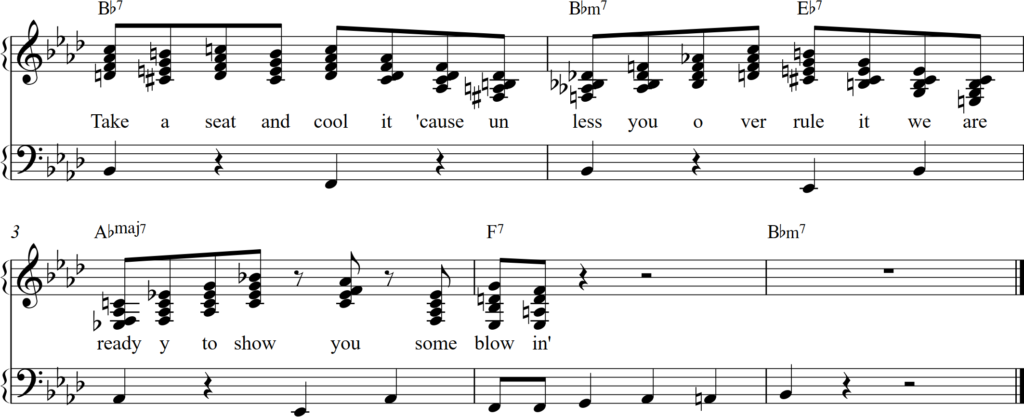
As you can see, the bass voice is moving separately from the other voices, providing the root note on the first beat of the bars. The bass doesn’t need any lyrics, in this case, it can sing something like “do” or “dum”.
The bass also provides a basic rhythm, so the arrangement becomes more rhythmical in this situation.
Another solution is when the main melody is singing “alone”, and the other voices are moving together – including the bass! Here is an example from the song “Few More Miles”, performed by Take 6:
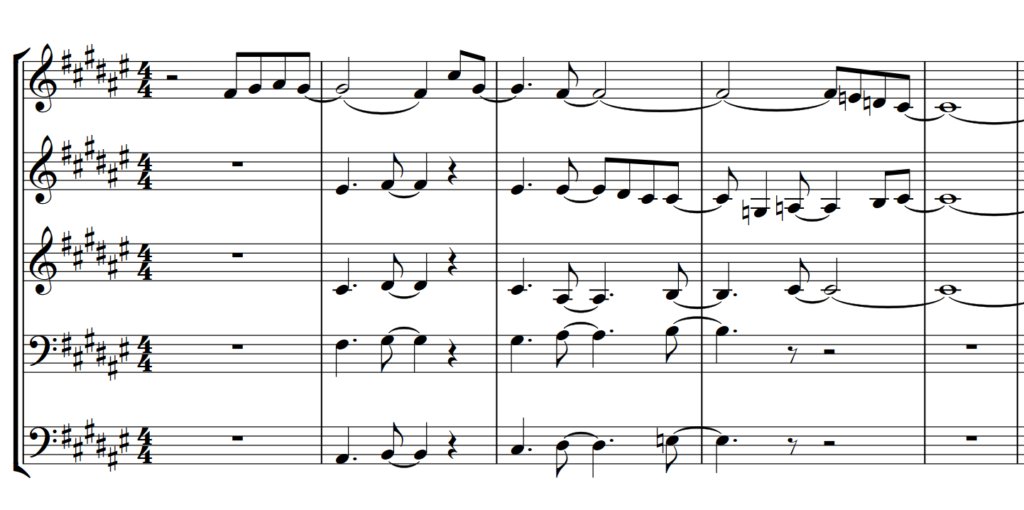
(Originally they sing this in six-voice, but I rearranged the song for a brass quintet.)
Another important aspect of writing for acapella groups is rhythm. Since there is no band, no drums, you need to arrange the vocals in a way that they sound good in rhythm. In order to do that, you can “steal” the arrangement of the original song.
For example, the song “Happy” by Pharrell Williams has many different instruments playing different kinds of rhythms. You can use these rhythms in your vocal arrangement.
Listen to the original bass line if it has an interesting rhythm. If there isn’t, you need to “rewrite” the bass line so it will be more interesting in rhythm.
Listen to the other instruments (the piano or guitar) to figure out if they are playing any rhythm in the original song. For example, this is how I arranged the song “Happy”:
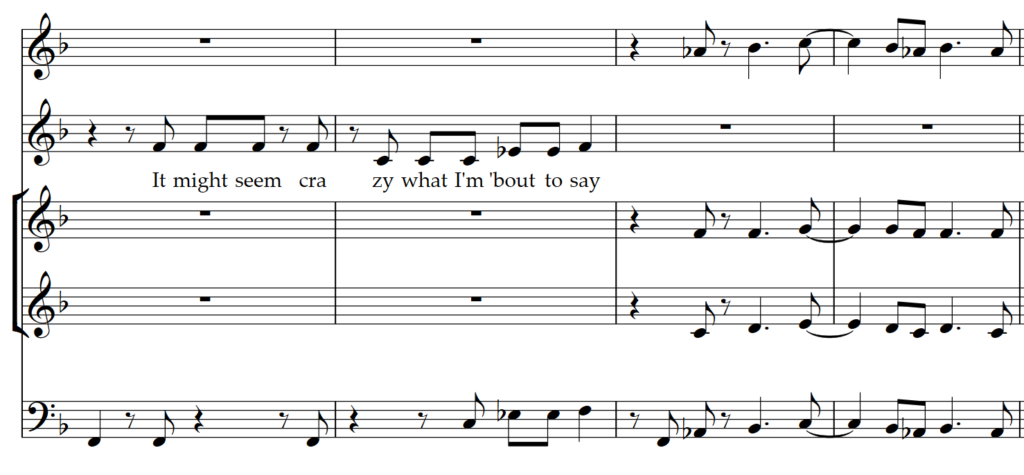
In Summary
– The simplest way to create background vocals is by creating long sustained harmonies. This is simple in rhythm, and you only need to use chord tones.
– Two voice is not enough to make a harmony, and four voices are unnecessary if you are only using triads.
– Use voice leading (keep the common notes of the chords at the chord changes, and move to the closest chord tone with the other voices.)
– Be aware of the style and mix of your music, vocal harmonies can disappear if there are many instruments playing simultaneously and the vocals are singing in lower ranges.
– Use background vocals only at some parts of the song (for example, in the chorus).
– If the melody is moving up and down, you can use the scale of the key.
– Two-voice writing: use mostly third and sixth intervals.
– Three voice writing: use mostly triads.
– If the main melody is not a chord tone, you can use passing chords.
– The background vocal can “echo” the lead singer.
– Four-voice writing: only makes sense if you use seventh chords.
– Avoid second intervals on the top.
– If the main melody is moving chromatically, you can use the diminished seventh chord.
– If the range is too high for the bottom voice, use the “drop 2” technique.
– If you write for an acapella group, consider using a bass voice.
– The bass can move separately from the other voices or together with them.
– You need a good rhythm if there is no band accompanying the vocals. Steal the rhythm from the original song, or create a new, interesting rhythm.
The secret pattern behind successful songs
Get the eBook for $7
